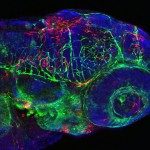Lien vers Pubmed [PMID] – 17604020
Exp. Cell Res. 2007 Aug;313(13):2766-79
Alexander disease (AxD) is a rare neurodegenerative disorder characterized by large cytoplasmic aggregates in astrocytes and myelin abnormalities and caused by dominant mutations in the gene encoding glial fibrillary acidic protein (GFAP), the main intermediate filament protein in astrocytes. We tested the effects of three mutations (R236H, R76H and L232P) associated with AxD in cells transiently expressing mutated GFAP fused to green fluorescent protein (GFP). Mutated GFAP-GFP expressed in astrocytes formed networks or aggregates similar to those found in the brains of patients with the disease. Time-lapse recordings of living astrocytes showed that aggregates of mutated GFAP-GFP may either disappear, associated with cell survival, or coalesce in a huge juxtanuclear structure associated with cell death. Immunolabeling of fixed cells suggested that this gathering of aggregates forms an aggresome-like structure. Proteasome inhibition and immunoprecipitation assays revealed mutated GFAP-GFP ubiquitination, suggesting a role of the ubiquitin-proteasome system in the disaggregation process. In astrocytes from wild-type-, GFAP-, and vimentin-deficient mice, mutated GFAP-GFP aggregated or formed a network, depending on qualitative and quantitative interactions with normal intermediate filament partners. Particularly, vimentin displayed an anti-aggregation effect on mutated GFAP. Our data indicate a dynamic and reversible aggregation of mutated GFAP, suggesting that therapeutic approaches may be possible.
